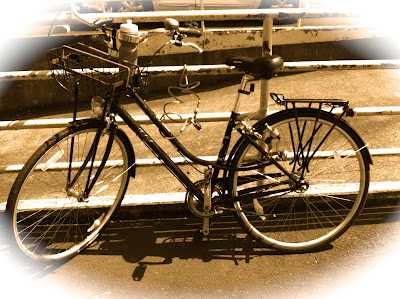When I purchased my last two bikes (the most recent being a 2012 Raleigh Classic Roadster), both times I chose what
has become known as a “step-through” frame. When I was younger, these were
universally called a lady’s or a girl’s frame—depending on the size. Few men
would be caught riding one.
A lot has changed since then…thank heavens.
First of all, I think sex roles have begun to become less
rigidly defined. Second, people who either visit Europe or the
utility cycling culture there know that the “step-through” frame is not
universally viewed as a woman’s bike design. It is commonly ridden by men, and is the basis for a wide variety of town-type bikes, often with a certain elegance built in to the frame pattern. Perhaps another important reason
is practicality: the step-through is a lot easier to deal with when riding with parcels, and in stop-and-go traffic.
One of the concerns I had in moving to the step-through
frame was strength. I’m no lightweight. I wondered if my being a fairly
solidly-built person would mean I could easily break the frame. I was assured
by those selling both bikes that I was nowhere near being in danger of that…especially because these were steel-framed bikes. I
certainly haven’t had any problems with either bike in riding around town, even
with considerable additional weight from items I’m carrying.
Step-through frames allow a person to mount a bike easily.
This is particularly true when carrying packages, bags, &c. on the rear
rack. Utility cycling really benefits from that capacity. This alone would seal the deal for me.
The step-through frame allows a person to do something else:
to dismount easily and safely. Since switching to a step-through, I have given
up counting the times when I was glad (especially in city traffic situations) not to have to deal with a high top tube! I can remember some fairly painful outcomes to life with a diamond frame in the past.
Some people express concern that a bike with a step-through
frame will be too wobbly. While I have noticed a bit of this when there is extra weight on the bike (packing a great deal of stuff around…and I do
mean a lot), it really has little
impact on things. The speeds at which a utility cyclist usually travels negates
much of the drawback. Probably the only clear downside with such a frame is
when transporting it on a rear-mounted car rack: one has to buy (and use correctly) a
special adapter that replaces a top tube. It costs extra, but is easy and
reliable.
The step-through frame makes a great deal of sense to me on
a practical level…and for the future. I can see myself being willing to cycle
about when I get older on such a bike more than a diamond frame. This frame style seems much more forgiving of an aging body.
Being a person committed to the “long haul” in life, this matters to me. I once heard that the best thing one can do for the environment is not to purchase a new car. While I’m not sure that is actually true any longer, I believe the underlying ethic—that long-term purchases and a simple, stable way of life is preferable to rampant consumerism—applies to bikes as well.
Being a person committed to the “long haul” in life, this matters to me. I once heard that the best thing one can do for the environment is not to purchase a new car. While I’m not sure that is actually true any longer, I believe the underlying ethic—that long-term purchases and a simple, stable way of life is preferable to rampant consumerism—applies to bikes as well.
I made an initial mistake in buying a bike with the wrong
geometry a while back, but when I finally found the right replacement bicycle, I stayed with the step-through frame.
I am delighted with the look, the practicality, and the message about the
nature of utility cycling it sends.

No comments:
Post a Comment